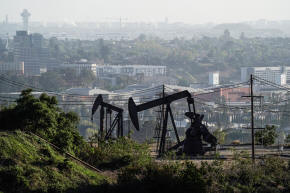|
Brent crude rose by 48 cents, or 0.5%, to $105.12 a barrel by
0808 GMT while U.S. West Texas Intermediate (WTI) crude futures
gained 28 cents, or 0.3%, to $100.88. Both benchmarks had surged
by more than 6% on Tuesday.
"The downside for oil prices is limited," said OANDA senior
market analyst Jeffrey Halley, citing the Russian comments on
peace talks and U.S. President Joe Biden accusing Russia of
genocide. These "are reinforcing that the Ukraine-Russia
situation will not be de-escalating any time soon".
Russian President Vladimir Putin on Tuesday blamed Ukraine for
derailing peace talks and said Moscow would not let up on what
it calls a "special operation" to disarm its neighbour.
Crude futures are also drawing support from Russian oil and gas
condensate production falling to below 10 million barrels per
day (bpd) on Monday, its lowest since July 2020.
The International Energy Agency (IEA) on Tuesday said it
expected Russian oil output losses to average 1.5 million bpd in
April, with losses growing to close to 3 million bpd from May.
Western sanctions against Russia and logistical constraints have
hampered trade, people familiar with the data said on Tuesday.
OPEC has warned that it would be impossible to replace potential
supply losses from Russia and signalled that it would not pump
more crude.
Reports this week of partial easing of some of China's tight
COVID-19 lockdown measures also underpinned oil prices.
Price gains, however, were kept in check by weak data from China
and Japan.
China's crude oil imports slipped 14% from a year earlier,
extending a two-month slide, as strict coronavirus restrictions
hit demand in the world's top crude importer.
Japan reported its biggest monthly fall in core machinery orders
in nearly two years, dragged down by a steep drop in demand from
IT and other service companies.
The Organization of the Petroleum Exporting Countries (OPEC) on
Tuesday cut its forecast for 2022 global oil demand growth,
citing the impact of Russia's invasion of Ukraine, rising
inflation as crude prices soar and the resurgence of the Omicron
coronavirus variant in China.
OPEC now expects global demand to grow by 3.67 million bpd in
2022, down 480,000 bpd from its previous forecast.
(Reporting by Ahmad Ghaddar; Additional reporting by Sonali Paul
in Melbourne and Isabel Kua in Singapore; Editing by David
Goodman)
[© 2022 Thomson Reuters. All rights
reserved.]
This material may not be published,
broadcast, rewritten or redistributed.
Thompson Reuters is solely responsible for this content.

|
|





